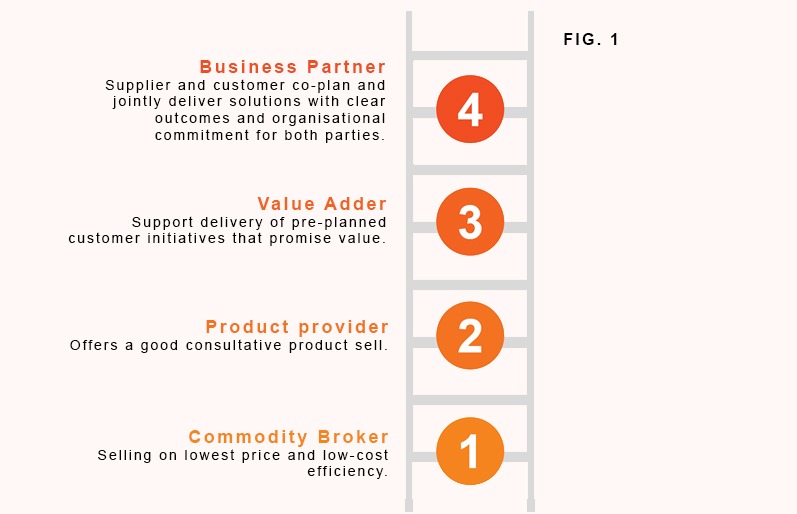Informed by our 20+ years of award-winning experience in pharma, this article will provide you with 10 tips that pharma key account managers can use to achieve successful key account management.
What does successful key account management deliver?
Excellent key account management is an ideal that has been pursued for decades by leaders, teams and key account managers in pharma.
Today successful key account management is when the customer sees a pharma company actively adding value i.e. they are working in partnership with them to co-plan and jointly deliver solutions that create positive outcomes for the customer, patient and organisation (see Fig.1).

But how can pharma key account managers shift customer perception and move up the ladder to ‘value adder’ or even ‘business partner’ status? Here are 10 tips on where to start…
10 tips for successful key account management
Prioritise accounts
No two accounts are the same – some will be of greater value or present better opportunities than others. It is crucial that a pharma key account manager recognises it is ok (and has permission) to focus their effort on the accounts with the greatest future potential. We have limited resources, so it is only by doing this that the results for the key account and business will be maximised.
Tip 1: The first step in prioritising accounts is of course to conduct a segmentation exercise – grouping accounts with similar characteristics or attributes to identify the best ‘match’ for a product or service. This will provide validated and grouped sets of accounts that could be proactively targeted i.e. “we will focus on segments A&B – they have account behaviours or characteristics that represent the best chance of success”.
Watch out!: Think about including more innovative Account behaviours and characteristics, not just the traditional perspectives you’ve used for so long.
Tip 2: Once accounts are segmented, look to ‘sort’ accounts into a priority order in order to actively engage an active mindset and ownership by the wider team. To do this effectively pharma key account managers should use local knowledge to decide objectively where to best invest time, energy and resources within the prioritised segments. To aid this process they should consider (i) the size of the potential opportunity in an account; (ii) how long it will take to make that opportunity happen, (iii) whether there is a customer in the account who is willing to make change happen.
Turn information into insight
Pharma key account managers will be armed with a plethora of data and information about their accounts. Whilst useful to have, it is crucial that they filter this information down and use it to form a very clear understanding of the potential opportunities to improve patient care that are available in an account and to decide which of those will best support the account and organisation to be successful.
Tip 3: Pharma key account managers should be actively encouraged to be more curious about account information from the account perspective – digging deep below ‘surface’ level information to build true understanding of an account. As part of this process, demonstrate the power of ‘why’ i.e. what is really happening in this account and why is that so?
Tip 4: To truly understand an account, pharma key account managers should capture a detailed patient journey which identifies areas (for example) where patients get stuck in the journey; where great care is already happening; where relevant decisions on patient treatment are being made etc. Having this level of detail and understanding will help to pinpoint where threats and possible opportunities exist in an account to supporting even better care and treatment.
Establishing the prime opportunity
By a key account manager fully understanding an account environment, they will be able to identify and validate a prime opportunity. Armed with this information they can establish an account plan that shows how the opportunity will support success for the organisation, account and their patients.
Tip 5: A prime opportunity should be mutually beneficial to the organisation and customer. Encourage key account managers to test the opportunity they’ve identified by asking this simple question:
“If one of the key change champions from this account was to view the account opportunities written in the plan, would they recognise them as something they would want to work on together, or merely see them as a drug company priority or opportunity?”
Tip 6: Demonstrate the importance of being clear about the best opportunity in an account and the rationale for why that is so. By establishing and articulating this, it will mobilise and focus the whole account team on that opportunity as they are clear on the expected outcomes and the plan that’ll help them get there.
Customer engagement
Building strong relationships with the right customers is crucial to successful key account management. When these relationships are formed it builds the influence and advocacy needed to engage key parties around an opportunity and the value it will deliver. This in turn, secures their buy-in and commitment to deliver against key actions that pull through expected outcomes.
Tip 7: Encourage pharma key account managers to use a stakeholder grid to identify the critical stakeholders within an account i.e. those who have the most impact or influence within an account in relation to their prime opportunity. These critical few stakeholders are often new or relationships we haven’t yet formed, we need to support the teams to be brave and go beyond their traditional call lists, especially given how so many organisations measure productivity – the right call is often the harder call to secure.
Tip 8: Informed by the stakeholder grid, a pharma key account manager should look to denote if that critical stakeholder is already bought into the prime opportunity (above) that has been defined. Those who have high influence/impact and buy-in should be prioritised in a customer engagement plan. For the other critical stakeholders with high influence who are not bought in we need a customer influencing plan.
Delivering value
When true value has been delivered, it is clear to all involved, and a good level of understanding around what and how that has been achieved exists. This insight is then capitalised to further scale up value that improves patient care in other key accounts.
Tip 9: To demonstrate how value has been delivered it is crucial that a key account manager co-creates the plan with the customer from the outset. Within this plan it should identify actions, account team and customer accountabilities and track progress against the key milestones required.
Tip 10: The plan should include Account critical success factor (CSF) i.e. “we won’t be able to successfully deliver this goal unless [critical circumstance] is achieved by [time]. We need to watch that we don’t simply push our Brand CSFs onto the Account agenda, but if we are truly working on a common goal together they should align!
Learn more about achieving successful key account management
Rubica has spent 20+ years working alongside and within pharmaceuticals companies, to support their evolution to a new way of working with customers. If you want to revolutionise how your team approaches key account management in pharma get in touch, or download our video ‘What it takes to achieve Key Account Excellence’.
 Paul Frith -
Paul Frith - 

